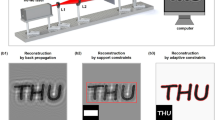Abstract
Digital holography is an imaging process able to recreate three-dimensional representations of objects from recording pattern interference among distinct waves. The in-line configuration setup is a variant considered the simplest physical implementation, providing a feasible manner for acquisition and the same time higher resolution for free-living microscopy imaging using a single illumination system. However, the well-known twin-image problem is bounded to the technique, since there is no separation among reference and objects beams in this configuration. As a result, computational numerical diffraction routines present the twin-image effect intrinsically, imposing several difficulties in terms of post-processing requirements. In this context, this paper aims to present a numerical approach able to provide consistent suppression of twin-image problem for in-line holography, during the numerical diffraction procedure for phase retrieval, combining image subtraction and edge detection techniques. The proposed solution was implemented in Python language, and metrics defined to assess it were both qualitative and quantitative, based on edge detection and some image comparison metrics. The obtained results of the proposed approach present a significant reduction in the twin-image artifacts in the reconstructions of both experimental and simulated holograms, considering a spherical reference wave, regardless of the shapes and sizes of objects.









Similar content being viewed by others
References
Gabor D (1948) A new microscopic principle. Nature 161:777–778
Kim Myung K (2011) Digital holographic microscopy. in principles techniques and application. Springer Series in Optical Sciences, New York
Kim MK (2011) Digital holographic microscopy: principles, techniques and applications, 1st edn. Springer, NY
Latychevskaia T, Fink HW (2015) Practical algorithms for simulation and reconstruction of digital in-line holograms. Appl Optics 54(9):2424–2434
Haeffele Benjamin D, Richard S, Geert V, René V (2017) Efficient reconstruction of holographic lens-free images by sparse phase recovery. In: M Descoteaux, L Maier-Hein, A Franz, P Jannin, DL Collins, and S Duchesne (ed) Medical image computing and computer-assisted intervention - MICCAI 2017 Springer International Publishing, Cham pages 109–117
Stoykova E, Kang H, Park J (2014) Twin-image problem in digital holography—a survey. Chin Opt Lett 12(6):60013
Sobieranski AC, Inci F, Tekin HC, Yuksekkaya M, Comunello E, Cobra D, von Wangenhein A, Demirci U (2015) Portable lensless wide-field microscopy imaging platform based on digital inline holography and multi-frame pixel super-resolution. Light: Sci Appl 4(10):e346
Latychevskaia T, Fink HW (2007) Solution to the twin image problem in holography. Phys Rev Lett 98(23):233901
Zhao J, Wang D, Zhang F, Wang Y (2011) Hybrid phase retrieval approach for reconstruction of in-line digital holograms without twin image. Opt Eng 50(9):091310
Rong L, Li Y, Liu S, Xiao W, Pan F, Wang D (2013) Iterative solution to the twin image problem in in-line digital holography. Opt Lasers Eng 51(5):553–559
Raupach SMF (2009) Cascaded adaptive-mask algorithm for twin-image removal and its application to digital holograms of ice crystals. Appl Opt 48(2):287–301
Hattay J, Belaid S, Lebrun D, Naanaa W (2014) Digital in-line particle holography: twin-image suppression using sparse blind source separation. Signal, Image Video Process 9(8):1767–1774
Hattay J, Belaid S, Naanaa W, Aguili T (2017) Adaptive vectorial lifting concept for convolutive blind source separation. Pattern Anal Appl 20(2):507–518
Rivenson Yair, Zhang Yibo, Günaydın Harun, Teng Da, Ozcan Aydogan (2018) Phase recovery and holographic image reconstruction using deep learning in neural networks. Light: Sci Appl 7(2):17141–17141
Rivenson Yair, Yichen Wu, Ozcan Aydogan (2019) Deep learning in holography and coherent imaging. Light: Sci Appl 8(1):85
Denis L, Fournier C, Fournel T, Ducottet C (2008) Numerical suppression of the twin-image in in-line holography of a volume of micro-objects. Measurement Sci Technol 19(7):074004
McElhinney CP, Hennely BM, Naughton TJ (2008) Twin-image reduction in inline digital holography using an object segmentation heuristic. J Phys: Conf Ser 139(1):012014
Cho C, Choi B, Kang H, Lee S (2012) Numerical twin image suppression by nonlinear segmentation mask in digital holography. Opt Express 20(20):22454–22464
Wang Z, Bovik AC, Sheikh HR, Simoncelli EP (2004) Image quality assessment: from error measurement to structural similarity. IEEE Trans Image Process 13(4):600–612
Author information
Authors and Affiliations
Corresponding author
Ethics declarations
Conflict of interest
The authors declare no competing interests.
Funding
This study was financed in part by the Coordenação de Aperfeiçoamento de Pessoal de Nível Superior—Brasil (CAPES)—Finance Code 001.
Availability of data and material
Not applicable.
Code availability
Not applicable.
Additional information
Publisher's Note
Springer Nature remains neutral with regard to jurisdictional claims in published maps and institutional affiliations.
Rights and permissions
About this article
Cite this article
de Almeida, J.L., Comunello, E., Sobieranski, A. et al. Twin-image suppression in digital in-line holography based on wave-front filtering. Pattern Anal Applic 24, 907–914 (2021). https://doi.org/10.1007/s10044-020-00949-7
Received:
Accepted:
Published:
Issue Date:
DOI: https://doi.org/10.1007/s10044-020-00949-7




